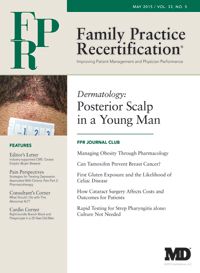Publication
Article
Family Practice Recertification
Industry-supported CME: Caveat Emptor (Buyer Beware)
Author(s):
Although commercial support for continuing medical education has been on the decline since 2008, it nevertheless continues to be a major revenue source for CME providers and a cause for potential concern.
Although commercial support for continuing medical education (CME) has been on the decline since 2008, it nevertheless continues to be a major revenue source for CME providers and a cause for potential concern. In 2013, Accreditation Council for Continuing Medical Education (ACCME)-accredited providers reported nearly $660 million in revenue from commercial sources, representing more than one fourth of total income. Industry support is a particularly important source of revenue stream for medical education and communication companies representing 43% of their income.
The centerpiece of efforts to ensure CME activities remain independent and free of commercial bias are the 2004 ACCME Standards for Commercial Support. This document comprises six Standards: Independence, Resolution of Personal Conflicts of Interest, Appropriate Use of Commercial Support, Appropriate Management of Associated Commercial Promotion, Content and Format without Commercial Bias, and Disclosures Relevant to Potential Commercial Bias.
Beginning in 2005, the ACCME attempted to fortify the firewall by requiring CME sponsors to actively resolve commercial conflicts of interest (COI) in their CME offerings. As opposed to simply having CME sponsors disclose to learners potential COI's declared by faculty, CME providers were mandated to employ more rigorous mechanisms for reducing the likelihood of commercial bias creeping into their CME offerings.
Identification and disclosure of COI's was not limited to just faculty, but to their spouses and activity planners (and their spouses) as well. For all with a COI, the CME provider must actively make an intervention for resolving the conflict. Possible mechanisms for resolving a COI include limiting teaching or planning or both to subject areas where the COI is not applicable, and excluding participation in the CME activity Refraining from discussing clinical implications of their presentation or from making treatment recommendations is also an option, as is restricting conclusions and recommendations to those based on the "best available medical evidence" from the medical literature, and requiring submission of the presentation or teaching materials for approval by a peer-review process prior to presentation.
The need for these measures is obvious when one considers the reliance of physicians on CME to improve their competency and performance. Although designed to buttress the barrier erected between CME and industry bias and synergistic with policies enacted by groups as diverse as the Pharmaceutical Research and Manufacturers of America and the Office of the Inspector General of the Department of Health and Human Services, it is unrealistic to think that they entirely eliminate the potential for bias in CME.
The best solution for minimizing any potential adverse impact of commercialism on CME lies not in more restrictive CME regulations but in measures designed to make the physician a critically thinking learner grounded in evidence-based medicine. Instead of taking at face value recommendations and conclusions drawn by CME faculty, it is important that physician learners demand to see and judge the evidence on which they are based.
The ACGME (Accreditation Council for Graduate Medical Education) and ABMS (American Board of Medical Specialties) have identified proficiency and engagement in evidence-based practice as well as effective use of information technology as critical elements for achieving practice-based learning and improvement.
Both the American Board of Family Medicine's maintenance of certification program (MC-FP) as well as the integration of evidence-based medicine by the AAFP into its CME program represents important steps towards helping family physicians achieve this end.
Suffice it to say that the greatest safeguard against commercial bias in CME ultimately rests in the ability of physician learners to recognize it when they see it.






